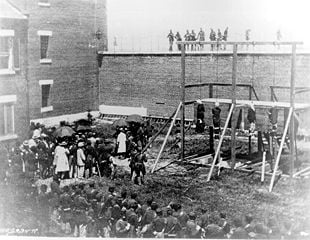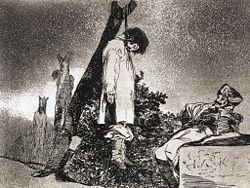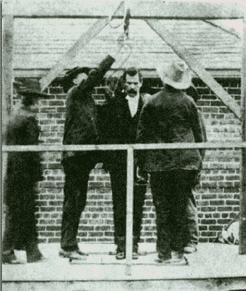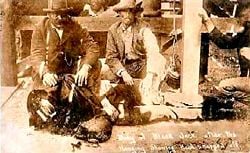Hanging
Hanging is the suspension of a person by a ligature, usually a noose or cord tied in a "Hangman's knot" wrapped around the neck, causing death. The knot in the noose is intended to jerk the victim's head back sharply enough to break the neck. Throughout history it has been used as a form of capital punishment. It was the usual method of execution in lynchings, and is also a common method of committing suicide.
While hanging, especially when carried out in public, is generally considered a rather inhumane method of execution it was the method of choice in numerous countries, particularly Great Britain and countries of the former British Empire for centuries. In its defense, several alternatives were more gruesome—drawing and quartering, burning at the stake, crucifixion, stoning, and so forth. Efforts were made to improve the hanging technique to ensure swift and painless death. In some countries efforts to be more humane resulted in a change in method of execution, the United States' use of the electric chair and lethal injection being notable. Others, such as Great Britain, abolished the death penalty itself; while still others continue with hanging as their method of execution, although the death penalty is rarely applied. Thus, from the history of attitudes toward the use of hanging can be seen a change from the extreme cases of "man's inhumanity to man" to increasing concern for the rights of all, even murderers, to receive humane treatment. The final conclusion of this advance, however, should be the end of violence against others and ourselves, and the ability of all to live in harmony as one human family.
Terminology
The Oxford English Dictionary states that hanging in this sense is "specifically to put to death by suspension by the neck," although it formerly also referred to crucifixion.[1]
The past tense and past participle in English of this meaning of the verb "to hang" is "hanged," whereas all other senses of the verb use "hung."
For lack of a better term, "hanging" has also been used to describe a method of suicide in which a person applies a ligature to the neck and, by means of partial suspension or partial weight-bearing on the ligature, brings about unconsciousness and then death. This method has been most often used in prisons or other institutions, where full suspension support is difficult to devise.
Hanging as a method of capital punishment
Hanging is the oldest but most widely used method of execution in the world today, with over 300 people hanged during 2006, many in public. The first recorded use of judicial hanging is in the Persian Empire approximately 2,500 years ago.[2] Along with widespread rejection of the death penalty as a punishment in many countries, hanging has come to be seen as a brutal method of execution. Formerly, hangings were conducted in public squares and used as a demonstration of the state's power and to embarrass the person being executed. Hangings were seen as a public spectacle, with people even using the occasion for a family picnic.[3]
It was the preferred method of execution in England for centuries, with public hangings until 1868. The use of hanging ended only with the abolition of the death penalty in 1964.[4] Hanging was a method of execution employed by the Nazis during World War II.
In a newspaper interview in 1957, Nikita Khrushchev commented regarding the failed 1956 Hungarian revolution that "support by United States … is rather in the nature of the support that the rope gives to a hanged man." [5] In keeping with the metaphor, the prime minister of Hungary during the revolution, Imre Nagy, was secretly tried, executed by hanging, and buried unceremoniously by the new Soviet-backed Hungarian government, in 1958. Nagy was later publicly rehabilitated by Hungary.[6]
Canada used hangings as its method of execution as late as 1962.[7] The Indian Supreme Court ruled that capital punishment would only be used in extreme cases.[8] One such example is that of Dhananjoy Chatterjee, who was convicted of the 1990 murder and rape of a 14 year old girl in Kolkata in India and was subsequently hanged.[9]
Hanging was the method of execution in the United States until the mid-twentieth century, and was commonly employed in lynchings. The last public hanging legally conducted in the United States (and also the last public execution in the United States) was that of Rainey Bethea, who was publicly hanged on August 14 1936, in Owensboro, Kentucky. By the last decade of the twentieth century hanging had been replaced by lethal injection as the standard method of carrying out the death penalty in states which retained this punishment. Among those with the death penalty, only three states retained hanging as an option; this was exercised three times in the 1990s—Billy Bailey in Delaware in 1996, and Charles Rodman Campbell (1994) and Westley Allan Dodd (1993) in Washington. In the first decade of the twenty-first century only two states, New Hampshire and Washington, continued to allow hanging as an option.[10]
Iran has continued to use hangings into the twenty-first century. On July 19, 2005, two boys, Mahmoud Asgari and Ayaz Marhoni, ages 15 and 17 respectively, who had been discovered to be having homosexual relations, were publicly hanged at Edalat (Justice) Square in Mashhad, on charges of homosexuality and rape.[11] As one of several means of capital punishment in Iran, hangings are carried out by using an automotive telescoping crane to hoist the condemned aloft. The death penalty is used for many offenses and is the only punishment for rape, murder, and child molestation, with all hangings taking place in public.
Iraq also continues to use hanging as its method of execution. In September 2005, three murderers were the first people to be executed since the downfall of Saddam Hussein. On March 9 2006, an official of Iraq's Supreme Judicial Council confirmed that Iraqi authorities had executed the first insurgents by hanging.[12]
In 2006, judicial hangings occurred in Bangladesh, Botswana, Egypt, Iran, Iraq, Japan, Jordan, Kuwait, Pakistan, and Singapore.[13] As of 2006, several countries still claim hanging to be their method of execution, although it has not necessarily been used recently. These include Japan, Singapore, Malaysia, South Korea, India, Pakistan, Bangladesh, Botswana, Zimbabwe, Iran, Iraq, Egypt, Jordan, Kuwait, Lebanon, and Syria, among others.[14]
Methods of judicial hanging
There are four methods of performing a judicial hanging — the short drop, suspension hanging, the standard drop, and the long drop. A mechanized form of hanging, the "upright jerker," was also experimented with in the nineteenth century.
Short drop
The short drop is done by placing the condemned person on the back of a cart, horse, or other vehicle, with the noose around his neck. The vehicle is then moved away leaving the person dangling from the rope. Prior to 1850, it was the main method used. This method is still used widely in Middle Eastern countries.[15] A ladder was also commonly used with the condemned being forced to ascend, after which the noose was tied and the ladder pulled away or turned, leaving the victim hanging.
Suspension hanging
Suspension hanging is similar, except the gallows themselves are movable, so that the noose can be raised once the condemned is in place. This method is currently used in Iran, where tank gun barrels or mobile cranes are used to hoist the condemned into the air. Similar methods involve running the rope through a pulley to allow raising of the person.

Standard drop
The standard drop, which arrived as calculated in English units, involves a drop of between four to six feet (1.2 to 1.8 meters) and came into use in the mid nineteenth century in English-speaking countries and those where judicial systems were under English influence. It was considered an advance on the short drop because it was intended to be sufficient to break the person's neck, causing immediate paralysis and immobilization (and perhaps immediate unconsciousness).
Long drop
The long drop process, also known as the measured drop, was introduced in 1872 by William Marwood as a scientific advancement to the standard drop. Instead of everyone falling the same standard distance, the person's weight was used to determine how much slack would be provided in the rope so that the distance dropped would be enough to ensure that the neck was broken.
Prior to 1892, the drop was between four and ten feet (about one to three meters), depending on the weight of the body, and was calculated to deliver a force of 1,260 lbf (5,600 newtons or 572 kgf), which fractured the neck at either the second and third or fourth and fifth cervical vertebrae. However, this force resulted in some decapitations, such as the famous case of "Black Jack" Tom Ketchum in New Mexico in 1901. Between 1892 and 1913, the length of the drop was shortened to avoid decapitation. After 1913, other factors were also taken into account, and the force delivered was reduced to about 1,000 lbf (4,400 N or 450 kgf).
Equipment
The equipment used in all of these methods is similar. Usually hanging involves the use of a noose, gallows, and hood often with the pinioning of the arms. The simplest type of noose is a simple slipknot. Variables include the length of or number of cords composing the rope. Gallows can be anything from a tree to more intentionally designed platforms with traps through which the condemned fall. Some places also use cranes as gallows.
The condemned is usually hooded before the act. There are three purposes for the hood: to prevent the prisoner from moving at the last second in reaction to the executioner's movements, to minimize rope burn on the prisoner before death, and to prevent officials and witnesses from seeing the dead person's face during and after the execution. Arms and legs are often pinioned, also to prevent the prisoner from moving during the execution.[16]
Medical effects
A hanging may cause one or more of the following medical conditions:
- Close the carotid arteries
- Close the jugular veins
- Induce carotid reflex, which reduces heartbeat when the pressure in the carotid arteries is high, causing cardiac arrest
- Break the neck (cervical fracture) causing traumatic spinal cord injury
- Close the airway causing cerebral ischemia
- Decapitation
The two primary causes of death are a broken neck or asphyxiation. Death occurs after some minutes, from asphyxia.[17]
The heart may continue to beat for some period after the brain can no longer be resuscitated. The time of death in such cases is a matter of convention. In judicial hangings, death is pronounced at cardiac arrest, which may occur at times from several minutes up to 15 minutes or longer after hanging. During suspension, once the prisoner has lapsed into unconsciousness, rippling movements of the body and limbs may occur for some time, which are usually attributed to nervous and muscular reflexes. In Britain, it was normal to leave the body suspended for an hour to ensure death.
Suicide
Suspension hanging is a common method of suicide. The materials necessary for suicide by hanging are relatively easily available to the average person, compared with firearms or lethal poison. Full suspension is not required, and for this reason hanging is especially commonplace among suicidal prisoners. A type of hanging comparable to full suspension hanging may be obtained by self-strangulation using a ligature of the neck and only partial weight of the body (partial suspension). This method is dependent on unconsciousness produced by arterial blood flow restriction while the breath is held.
- In Canada, hanging is the second most common method of suicide,[18] after suffocation.
- In the United States, hanging is the second most common method of suicide, after firearms.[19]
- In Great Britain, where firearms are less easily available, as of 2001 hanging was the most common method among men and the second-most commonplace among women (after poisoning).[20]
Notable Examples of Judicial Hangings
- Bulgaria's national hero, Vasil Levski, was executed by hanging by the Ottoman court in Sofia in 1873.
- Brazilian national hero Tiradentes (1792) was killed by hanging.
- Nathuram Godse, Mohandas Gandhi’s assassin, was executed by hanging in 1949.
- Saddam Hussein the former leader of Iraq, was hanged after being found guilty of brutal executions
- Nazi war criminal Adolf Eichmann was hanged in Israel after being captured by Mossad agents in Argentina in 1961.
- Those convicted of war crimes at the Nuremberg Trials following World War II were hanged.
- During the Salem Witch Trials in Salem, Massachusetts, many accused of witchcraft were hanged.
Alternatives to Hanging
Because of the variables involved in hanging, opponents have criticized it as a particularly inhumane method of execution. This criticism is driven by stories of hangings taking hours or of the horrible pain it might cause in comparison with other methods. As a result, hanging is no longer commonly used in the western world, where other methods of execution have supplanted hanging as the method of choice. These modern alternative methods include lethal injection and the gas chamber. Historically, other methods of execution included firing squad and electric chair, although these two have fallen out of favor for their barbarism. Even the more humane treatments have been questioned for the pain they cause to prisoners.[21]
Many people have criticized the death penalty in general, saying that "two wrongs do not make a right," and thus added their voices in opposition to hanging. Opposition is led by such groups as Amnesty International, the Human Rights Watch, and various religious groups opposed to executions.
Notes
- ↑ Oxford English Dictionary Hanging Oxford English Dictionary. Retrieved April 14, 2007.
- ↑ Richard Clark"The process of judicial hanging", Capital Punishment U.K. Retrieved April 15, 2007.
- ↑ Michel Foucault. Discipline & Punish. Vintage (1995). ISBN 0679752552.
- ↑ Clark History of British judicial hanging. Capital Punishment UK. Retrieved April 12, 2007.
- ↑ James Simpson. Simpson's Contemporary Quotations. (Collins, 1997. [1]. ISBN 0062701371) Retrieved April 25, 2007.
- ↑ Richard Solash Hungary: U.S. President To Honor 1956 Uprising Radio Free Europe. Retrieved April 10, 2007.
- ↑ Susan Munroe, History of Capital Punishment in Canada About: Canada Online. Retrieved April 23, 2007.
- ↑ Monica Sakhrani and Maharukh Adenwalla, "Death Penalty - Case for Its Abolition" Economic & Political Weekly March 12, 2005. Retrieved April 23, 2007.
- ↑ Sarath Kumara"West Bengal carries out first hanging in India in a decade"World Socialist Web Site, 30 September 2004. Retrieved April 23, 2007.
- ↑ Authorized Methods by State, Death Penalty Information Center. Retrieved April 13, 2009.
- ↑ BBC News Iran 'must stop youth executions' BBC News. Retrieved April 10, 2007.
- ↑ Bushra Juh bombs bring death to Iraq Mail & Guardian Online, AP, 2006-03-10, accessdate 2006-04-27.
- ↑ ClarkThe process of judicial hanging Capital Punishment UK. Retrieved April 12, 2007.
- ↑ Ibid. The process of judicial hanging Capital Punishment UK. Retrieved April 12, 2007.
- ↑ International Noose Washington Post. Retrieved April 9, 2007.
- ↑ The Process of Judicial Hanging Capital Punishment UK. Retrieved April 15, 2007.
- ↑ Hanging Injuries and Strangulation. eMedicine. Retrieved April 14, 2007.
- ↑ Statistics about suicide. WrongDiagnosis.com [2] Retrieved April 13, 2007.
- ↑ Suicide Statistics, Suicide.org. Retrieved April 25, 2007.
- ↑ Trends in suicide by method in England and Wales, 1979 to 2001 (PDF), Office of National Statistics. Retrieved April 25, 2007.
- ↑ Human Rights Watch Florida, California: Lethal Injection Under Attack Human Rights Watch. Retrieved April 15, 2007.
ReferencesISBN links support NWE through referral fees
- Duff, Charles. 1999. A Handbook on Hanging. New York Review Books Classics. ISBN 0940322676
- Gatrell, V.A.C. 1996. The Hanging Tree: Execution and the English People 1770-1868. Oxford University Press. ISBN 0192853325
- Kellaway, Jean. 2004. The History of Torture & Execution: From Early Civilization through Medieval Times to the Present. Mercury Books. ISBN 1904668038
- Steelwater, Eliza. 2003. The Hangman's Knot: Lynching, Legal Execution, and America's Struggle with the Death Penalty. Westview Press. ISBN 081334042X
Credits
New World Encyclopedia writers and editors rewrote and completed the Wikipedia article in accordance with New World Encyclopedia standards. This article abides by terms of the Creative Commons CC-by-sa 3.0 License (CC-by-sa), which may be used and disseminated with proper attribution. Credit is due under the terms of this license that can reference both the New World Encyclopedia contributors and the selfless volunteer contributors of the Wikimedia Foundation. To cite this article click here for a list of acceptable citing formats.The history of earlier contributions by wikipedians is accessible to researchers here:
The history of this article since it was imported to New World Encyclopedia:
Note: Some restrictions may apply to use of individual images which are separately licensed.



